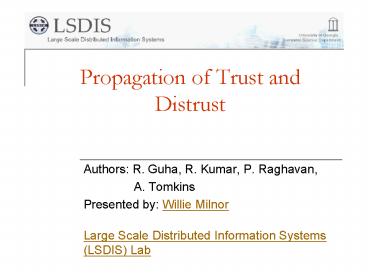Propagation of Trust and Distrust - PowerPoint PPT Presentation
1 / 20
Title:
Propagation of Trust and Distrust
Description:
Propagation of Trust and Distrust. Authors: R. Guha, R. Kumar, P. Raghavan, A. Tomkins ... Trust in Online Auction Markets Through an Economic Interative Mechanism. ... – PowerPoint PPT presentation
Number of Views:573
Avg rating:3.0/5.0
Title: Propagation of Trust and Distrust
1
Propagation of Trust and Distrust
- Authors R. Guha, R. Kumar, P. Raghavan,
- A. Tomkins
- Presented by Willie Milnor
- Large Scale Distributed Information Systems
(LSDIS) Lab
2
Outline
- Motivation
- Related Work
- Framework
- Algorithms
- Data
- Experiments
- Results
3
Motivation
- information sharing
- products, employment, reality, etc
- economic motivation to spread information
- open standards
- possible exploitations
- solution web of trust
- users rate users
- web helps users assess users
- e-commerce and recommendation systems
4
Approaches to Trust
- natural aggregation of opinions
- coalition of users with biased opinions
- trust relationships
- built over time
- recursive trust
- benefits
- individually tailored data
- encourage trustworthy behavior
- social networks and economics
5
Distrust
- recent mathematical approaches to trust
- distrust not considered
- users can distrust users
- Epinions and EBay
- challenges
- zero value or no opinion
- negative value unreal eigenvector
- chain of distrust
- unscrupulous users
6
Summary of Work
- typically spare networks
- non explicit trust relationships
- taxonomy of schemes for propagation
- web of trust from Epinions
- empirical study on large data set
- ranked by predictive accuracy
- accuracy vs. response time
7
Related Work
- non computational
- affects on beliefs and decision making
- trust in political science
- cryptography and authentication
- PGP1 used web of trust
- The Tipping Point2
- information flow mediation
- business management Ackerlof3
- sellers trustworthiness on quality of a product
- game theoretic approach4
- authenticating third party
8
Framework
- n users
- n x n matrices T and D
- tij is trust in j
- 0 lt tij lt 1
- same for D - distrust
- predict unknown values from T and D
- M generic belief matrix
9
Atomic Propagation
- basis set of techniques
- direct propagation M
- A trusts B trust(A) propagates to B
- co-citation MTM
- A trusts B,C trust(B) propagates to C
- transpose trust MT
- A trusts B trust(B) propagates to A
- trust coupling MMT
- A,B trust C trust(A) propagates to B
10
Propagation of Distrust
- weight and sum each matrix RM
- matrix P(k)
- pij propagation from i to j after k applications
of the basis set - 3 models based on distrust
- trust-only M T P(k) RkM
- one-step distrust M T P(k) RkM (T D)
- propagated distrust M T D P(k) RkM
11
Iterative Propagation
- final matrix F
- each P(k) propagation via paths of length k
- suitably chosen integer K
- eigenvalue propagation
- F P(K)
- weighted linear propagation
- constant y
- F sum((yk) (P(k)))
12
Rounding
- Should i trust j?
- global rounding
- align trust/distrust ratio in F to that in M
- based on a threshold overall relative fraction
- local rounding
- take into account trust/distrust behavior of I
- threshold based on i
- majority rounding
- unknown value is that of the smallest majority of
a local neighborhood - capture original local structure
13
Distrust Transitivity
- trust transitivity
- i trusts j, j trusts k
- i trusts k
- i distrusts j, j distrusts k
- multiplicative does i trust k ?
- additive does i strongly distrust k ?
- if mij is not 0, mij exp(mij)
- otherwise, mij 0
14
Experimental Data
- Epinions
- taxonomy of reviewable objects
- users review on 2-5 axes
- overall ratings
- users review other users
- indicate trust/distrust
- users rate reviews of other users
- reviewers paid royalties
- efforts to rig system
- distrust
15
Trust Graph
- directed graph
- 131829 nodes
- 841372 edges
- indegree and outdegree
- large strongly connected component (SCC)
- 41441 nodes
- bowtie structure5
- undirected
- giant weak connected component
- 119130 nodes
16
Experiments
- multiplicative distrust only
- 81 experimental categories
- based on algorithmic framework
- does i trusts j ?
- remove single (i,j) from graph
- run algorithm on each category
- Lanczos style matrix operation
- matrix vector multiplication
- overall low errors
17
Results
- basis elements
- weighted propagation
- distrust
- one-step
- rounding
- majority clustering
- iteration
- EIG with one-step distrust (usually)
- path length K
- most dramatic for direct propagation
18
Conclusions
- trust propagation fundamental to ecommerce
- formal framework of trust propagation
- introduction of distrust
- evaluate schemes on real-world data
- predictive system
- effects of various phenomena
19
- Questions Comments
20
References
- 1 B. Yu and M. P. Singh. A Social Mechanism of
Reputation Management in electronic commerce.
Cooperative Information Agents, pages 154-165,
2000 - 2 M. Gladwell. The Tipping Point, How Little
Things Can Make a Big Difference. Little Brown,
February 2000. - 3 G. Ackerlof. The Market of Lemons Quality,
Uncertainty and the Market Mechanism. Quarterly
Journal of Economics, 84488-500, 1970. - 4 S. Ba, A. B. Whinston, and H. Zhang.
Building Trust in Online Auction Markets Through
an Economic Interative Mechanism. Decision
Support Systems, 2002. - 5 A. Z. Broder, R. Kumar, F. Maghoul, P.
Raghavan, S. Rajagopalan, R. Stata, A. Tomkins,
and J. Wiener. Graph Structure in the Web.
WWW9/Computer Networks, 33(1-6)309-320, 2000.































